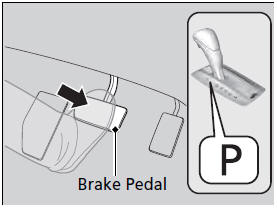 Honda Accord: Starting the Engine
Honda Accord: Starting the Engine

1. Make sure the parking brake is applied.


2. Check that the shift lever is in
 , then
depress the brake pedal.
, then
depress the brake pedal.
- Although it is possible to start the vehicle
in  , it is safer to start it in
, it is safer to start it in
 .
.


2. Check that the shift lever is in
 . Then
depress the brake pedal with your right
foot, and the clutch pedal with your left
foot.
. Then
depress the brake pedal with your right
foot, and the clutch pedal with your left
foot.
- The clutch pedal must be fully depressed
to start the engine.
Keep your foot firmly on the brake pedal when starting the engine.
The engine is harder to start in cold weather and in thinner air found at altitudes above 8,000 feet (2,400 meters).
When starting the engine in cold weather, turn off all electrical accessories such as the lights, heating and cooling system*/climate control system*, and rear defogger in order to reduce battery drain.
If you live in a region where winter is extremely cold, an engine block heater will improve starting and warming of the engine. If temperatures consistently below -22°F (-30°C) are expected, the coolant mixture should be charged to a higher concentration to prevent freezing. Consult a dealer for details.
If the exhaust system sounds abnormal or you can smell exhaust gas inside the vehicle, have your vehicle checked by a dealer. There may be a problem with the engine or exhaust system.

3. Turn the ignition switch to START
 without depressing the accelerator pedal.
without depressing the accelerator pedal.
Do not hold the key in START (e for more than 15 seconds.
• If the engine does not start right away, wait for at
least 10 seconds before trying again.
• If the engine starts, but then immediately stops,
wait at least 10 seconds before repeating step 3
while gently depressing the accelerator pedal.
Release the accelerator pedal once the engine
starts.
The immobilizer system protects your vehicle from theft. If an improperly coded key (or other device) is used, the engine's fuel system is disabled.
• Starting to Drive

1. Keeping your right foot on the brake pedal, release the parking brake.
Check that
the brake system indicator has gone off.
2. Put the shift lever in  . Select
. Select
 when reversing.
when reversing.
3. Gradually release the brake pedal and gently depress the accelerator pedal to
pull
away.
• Hill start assist system
Hill start assist keeps the brake engaged briefly to help prevent the vehicle from rolling on inclines as you move your foot from the brake pedal to the accelerator.

Depress the clutch pedal, and shift to
 when facing uphill, or
when facing uphill, or
 when facing
downhill, then release the brake pedal.
when facing
downhill, then release the brake pedal.

Move the shift lever to  ,
,
 , or
, or
 * when facing uphill, or
* when facing uphill, or
 when facing
downhill, then release the brake pedal.
when facing
downhill, then release the brake pedal.
Hill start assist may not prevent the vehicle from rolling downhill on a very steep or slippery slope, and does not operate on small inclines.
Hill start assist is not a replacement for the parking brake.

 When Driving
When Driving
...
 Starting the Engine
Starting the Engine
1. Make sure the parking brake is applied.
2. Check that the shift lever is in
, then
depress the brake pedal.
- Although it is possible to start the vehicle
in , it is safer to st ...
See also:
Selector Control Shaft Oil Seal
Replacement
Special Tools Required
-Driver Handle, 15 x 135L 07749-0010000
•Attachment 22 x 24 mm 07746-001A800
1. Remove the oil seal (A) from the end cover (B).
2. Install a new oil seal flush to the ...
VTC Actuator Inspection
1. Remove the cam chain (see page 6-62).
2. Loosen the rocker arm adjusting screws (see step 2 on
page 6-81).
3. Remove the camshaft holder (see step 3 on page
6-81).
4. Remove the intake c ...
